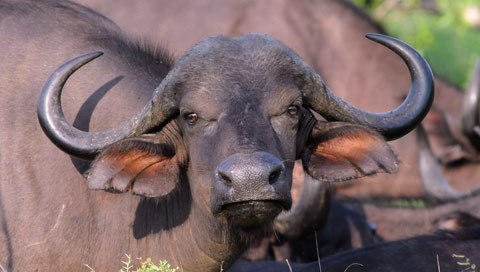
Buffalo aren’t just large, lumbering animals; they are often considered unpredictable. Just like the bison that inspired their name, they have a wild spirit and a strong instinct for self-preservation. Let’s dive into the fascinating world of buffalo and explore what makes them potentially dangerous to humans, the behaviors that lead to confrontations, and how to stay safe in their presence.
Understanding Buffalo Behavior
Buffalo are massive animals, and their sheer size can be intimidating. An adult buffalo can weigh over 2,000 pounds and stand nearly 6 feet tall at the shoulder. Picture that for a second—a creature that big can certainly cause some serious harm if it feels threatened. But what drives buffalo behavior? Honestly, like many wild animals, buffalo have a “fight or flight” response that kicks in when they perceive danger.
You might be wondering what triggers this response. Buffalo can become aggressive for several reasons. They may feel cornered, threatened, or protective of their young. Imagine a mother buffalo with her calf; she’s likely to be extra defensive. In fact, buffalo can be surprisingly fast and agile, sprinting up to 35 miles per hour! That’s faster than most humans can run. Understanding their behavior is key to respecting their space.
Buffalo are social animals and often travel in groups, which can also affect their behavior. When one buffalo feels threatened, the entire herd might react. It’s like a team of athletes—if one player gets nervous, the rest might feel the tension too. Sometimes, a lone buffalo might stray from the herd and become more unpredictable, especially if it feels vulnerable. So, when you encounter them, it’s crucial to observe their group dynamics and overall demeanor.
When Buffalo Attack: Real-Life Stories
It’s not just a myth that buffalo can be dangerous; there are real stories that illustrate this risk. In Yellowstone National Park, there have been numerous incidents where tourists have gotten too close to buffalo while taking photos. One such story involves a man who tried to approach a buffalo for a selfie. Unfortunately, the animal didn’t appreciate the invasion of its personal space and charged at him, resulting in serious injuries.
These incidents serve as a powerful reminder of the unpredictable nature of buffalo. They might look calm and peaceful, but like any wild animal, they can react suddenly if they perceive a threat. So, here’s the thing: maintaining a safe distance is essential. National parks typically have guidelines advising visitors to stay at least 25 yards away from buffalo. Respecting this boundary isn’t just for your safety; it’s also important for the animals.
You might be curious about what might provoke a buffalo’s aggression. Besides unexpected encounters, loud noises, and sudden movements can also trigger a buffalo’s defensive instincts. Imagine if you were enjoying a peaceful picnic and someone suddenly jumped out at you—that might just spark a fight-or-flight response!
How to Safely Observe Buffalo
If you’re eager to see buffalo in their natural habitat, safety should be your top priority. Here are some guidelines to make your experience enjoyable and safe:
- Stay at a Distance: As I mentioned earlier, always keep at least 25 yards away from buffalo.
- Be Quiet: Keep noise levels low to avoid startling them.
- Stay Calm: If a buffalo does approach, stay still and avoid sudden movements.
- Watch for Signs: Pay attention to the animal’s body language—snorting or pawing at the ground can indicate they feel threatened.
- Know When to Leave: If a buffalo appears agitated, it’s best to back away slowly and leave the area.
These simple steps can make a big difference in how you interact with buffalo. Just remember, you’re a guest in their territory, and respecting their space is crucial for both your safety and their well-being.
The Role of Buffalo in Their Ecosystem
Buffalo play an important role in their ecosystems, contributing to the health of grasslands and providing habitats for other species. They graze on grass, which helps maintain the landscape. Their hooves also create small disturbances in the soil, promoting new plant growth. You might think of them as nature’s gardeners—helping the environment thrive while also living their best lives.
However, as buffalo populations grow, they can sometimes come into conflict with human activities, particularly in agricultural areas. Livestock owners may be concerned about the competition for grazing land or the potential for disease transmission. That’s why understanding buffalo and their impact on the environment is essential. It’s a delicate balance, and finding ways for humans and buffalo to coexist is critical.
In places like Yellowstone, conservation efforts focus on maintaining buffalo populations while managing human interaction. It’s fascinating how much thought goes into these strategies to ensure both buffalo and humans can thrive together.
So, can buffalo be dangerous to humans? The short answer is yes, but with understanding and respect, you can enjoy observing these magnificent creatures without incident. Buffalo are wild animals that deserve our admiration—and a healthy respect for their space. Remember that staying safe around buffalo involves understanding their behavior, maintaining a respectful distance, and knowing how to react in their presence.
The next time you think about buffalo, I hope you’ll see them not just as fascinating wildlife, but as powerful animals that deserve our caution and respect. Whether you’re visiting a national park or simply admiring a story about them, keep their wild nature in mind. It’s all about finding that balance between appreciation and safety.
